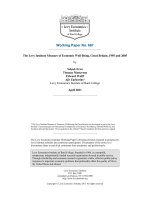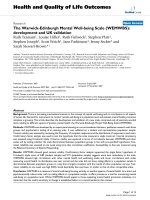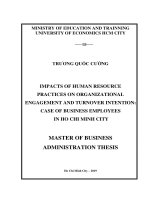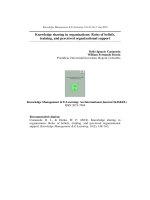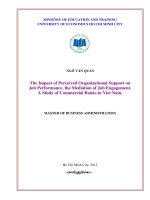Time pressure, employee well being, perceived organizational support and turnover intention of information technology executives in malaysia a proposed conceptual framework
Bạn đang xem bản rút gọn của tài liệu. Xem và tải ngay bản đầy đủ của tài liệu tại đây (353.35 KB, 5 trang )
RESEARCH ARTICLE
Adv. Sci. Lett. 4, 400–407, 2011
Copyright © 2011 American Scientific Publishers
All rights reserved
Printed in the United States of America
Advanced Science Letters
Vol. 4, 400–407, 2011
Time Pressure, Employee Well-being,
Perceived Organizational Support and
Turnover Intention of IT Executives in
Malaysia: A Proposed Conceptual
Framework
Naseebullah Langove1, Ahmad Shahrul Nizam Isha2 and Muhammad Umair Javaid3
1,2,3
Department of Management and Humanities, Universiti Teknologi PETRONAS
Bandar Seri Iskandar, Tronoh (31570) Perak, Malaysia
Globalization stimulates the role of information technology (IT) among emerging market and creates new challenges for
organizations to be competitive to survive in the market. These challenges alter and threaten the capability of employees in
their working environment. Time pressure is regarded as one of key factors which negatively contribute to the employee
turnover among IT Executives in Software Companies. This study in response to this issue aims to examine the impact of
time pressure on well-being and turnover intention with the moderating role of perceived organizational support. This study
is based on a conceptual framework and the data will be collected to observe the relationship between time pressure,
employee well-being, perceived organizational support and turnover intention with the help of structural equation modeling.
To the best knowledge of researcher, none of the study has found out the time pressure with the mediating variable of
employee well-being and moderating variable of perceived organizational support.
Keywords: Time Pressure, Well-being, Turnover Intention, Perceived organizational support
1. INTRODUCTION
Time pressure is one of challenging and critical factor
which also oblige towards turnover. Time pressure is the
demand to work faster than usual to complete the given
tasks 1-3. Many projects groups have hard time to meet the
deadline4. A survey conducted among 91 managers of
project teams, where 56% indicated to fail in achieving
the deadlines5. A high work pressure could lead to a stress
and this usually leads to a turnover. The definition of
turnover intention is pertinently defined as “the conscious
and deliberate wilfulness to leave the organisation”(p.
262)6. High turnover may have some disruptive
consequences in terms of impaired organizational
operational, service delivery and administration7. It also
affect the costs of employee’s re-hiring and re-training for
*
Email Address:
1
Adv. Sci. Lett. Vol. 4, No. 2, 2011
organizations8. In IT industries, turnover intention is very
high in comparison to other fields in view of inconstancy,
unpredictability and inconsistence of the IT field9. As
outlined by (HayGroup)10 where they projected that the
turnover will certainly increase, particularly in the
developing economies in Asia as well as in Latin America.
An additional report of (Aon Hewitt, 2009-2011)11
pointed out that Malaysia had a turnover rate of 15. 9% in
2011, showing a rise over the last years and considered in
the sixth position among Asia Pacific countries.
Malaysian Employers Federation (MEF) executive
director Shamsuddin Bardan reported that the highest
annual turnover rate has been found in the service
sector of IT with 75.72%12. Comparatively, the IT
industries found to be affected more in turnover intention
in Malaysian contexts.
1936-6612/2011/4/400/008
doi:10.1166/asl.2011.1261
Adv. Sci. Lett. 4, 400–407, 2011
In organizations employees frequently feel two types of
job in terms of stresses; those are positive and negative
dimension. The positive dimension refers to the concepts
of well-being and ability to cope with the face of
adversity, whereas the negative one includes
psychological and psychiatric disorders13. Coupled with
the pressing organizational demands to retain a healthy,
optimally functioning and engaged workforce suggests a
necessity of research in the field of workplace well-being
14-16
. A number of employees in European communities
are interested with improving and sustaining employee
well-being and many are also enthusiastic to take pay-cuts
to be healthier and happier17. Nevertheless, a very little
empirical research has been conducted on time pressure in
context of employee well-being to retain employees for
longer period of time.
This study inspires us to observe an intensive
literature review of time pressure that critically affects
and negatively contributes to the turnover intention
among IT executives based on moderated and mediation
role of perceived organizational support (POS) and
employee well-being.
2. LITERATURE REVIEW
A. Time Pressure
Time scarcity is defined as “the difference between the
amount of required and available time at one’s disposal
while performing an activity”18. A time pressure is the
degree to which people being aware of time limits and
feel to have too much to do in too little time, which more
they experience time pressure 19. Time pressure has been
directly or indirectly documented in several studies. For
instance, the level of cortisol complains of employees
about work overload during the work week and less
complain about cortisol level in a weekend20. A number of
studies had shown a risk of developing illness due to
highly demanding work requests like time scarcity and
overtime hours21-23. Other studies also demonstrated that
time pressure has negatively affected the performance19,24.
Time pressure has a negative effect on well-being 19,25.
B. Perceived Organizational Support
Perceived organizational support construct is one of
the focus relationships between employee-organization26.
Further they stated that employees react what they receive
from organization to form “global perceptions concerning
the extent to which the organization values their
contributions and cares about their well-being”26.
Perceived organizational support is also defined as “how
much the organization values employee’s contributions
and cares about them”27. Perceived organizational support
is one of the great interest variables among analysts in
terms of job satisfaction and well-being28. Organizations
sufficient support to employees in return will give
optimum level of performance29,30. Basically perceived
organizational support is the degree where employees feel
that organization fairly treat and compensate on behalf of
RESEARCH ARTICLE
their efforts31. When perceived organizational support is
higher among employees, the reciprocity norm32
stimulates them and work hard to achieve organizational
goals and objectives26. Perceived organizational support
can be achieved by fulfilling employee’s socio-emotional
needs and extra efforts reward will help employees to do
better jobs26. The purpose behind perceived organizational
support is to increase employee’s attachment to the
organizations; in return employees give more value and
adopt organizations regulations and principles28.
Perceived organizational support absolutely mediates the
relationship between career development and internal
promotion with turnover intention among knowledge
workers33.
Some studies have found that organizational support
plays a significant buffering effect in pressure results and
retention intention34. Another study mentioned that
perceived organizational support can release the effect of
stress35.
C. Employee Well-Being
It is explained in the study that organizational
commitment, job satisfaction, and well-being at work are
the predictors of the coming out of turnover intentions36.
A study revealed that a positive impact of well-being on
job satisfaction and negative impact on turnover
intention37. Having satisfied their well-being at work,
employees might be more productive, positively
contributing to the organization's goals, and making
intentions to leave minimized38. An employee well-being
has a significant contribution to the enhancement of
productivity and organizational performance39. Hence, it
also enhances customer service, profitability, and
minimizes employee turnover and absenteeism40. Based
on this above statement, it clearly states that the wellbeing of employee reduce the turnover intention.
D. Turnover Intention
The definition of turnover intention has been defined as:
“the conscious and deliberate willfulness to leave the
organization” (p. 262)6. Two types of Turnover are
voluntary and involuntary turnover. Voluntary turnover
is about a process where an employee making decision on
staying or leaving the organization, while involuntary
turnover is a situation where an organization has the
control over the employee’s decision in staying or leaving
the organization41.
Ratcheting up of workloads and work time expectations
that increase time pressure on all workers42 and also this
gesture will increase the level of turnover. Employee’s
turnover is positively related to workload (time
pressure)43.
Employee well-being has a significant contribution to the
enhancement of productivity and organizational
performance39. Having fulfilled their well-being in
workplace, employees might be more productive,
positively contributing to the organization's goals, and
2
RESEARCH ARTICLE
making less intention to leave organizations38. Well-being
has a significant impact on job satisfaction and negative
impact on turnover intention37. Hence, it also enhances
customer service, profitability, and minimizes employee
turnover and absenteeism (Amin & Akbar, 2013).
3. ORGANIZATIONAL SUPPORT THEORY
According to organizational support theory, the
development of perceived organizational support is
encouraged by employee’s tendency to assign the
organization human like characteristics44. On the basis of
the organization’s personification, employees view their
favorable or unfavorable treatment as an indication that
the organization favors or disfavors them45. Further
adding elaborating to the point, they also mentioned that
organizational support theory addresses the psychological
processes underlying consequences of perceived
organizational support in three perspectives.
First, on the basis of mutually exchange to care about
organization’s welfare and to help the organization in
achieving its objectives.
Second, the caring, approval, and respect predicted by
POS should be fulfilling socio-emotional needs, leading
workers to incorporate organizational membership and
role status into their social identity.
Third, POS should strengthen employee’s beliefs that
organization recognizes and rewards will also increase the
performance of the organization. These processes should
have favorable outcomes both for employees (e.g.,
increased job satisfaction and heightened positive mood)
and for the employers (e.g., increased affective
commitment, performance and reduced turnover).
4. Conceptual Framework
Theoretical framework highlights and explains the key
components of well-being at workplace of IT executives.
The proposed framework has been developed based on indepth literature and knowledge. The key constructs of
employee well-being at the workplace have been
identified as a mediating variable of the framework. In
line with our perspective, the concept of well-being has
been considered as the comprehensive and more
enriching construct of the framework. The well-being of
employees apparently is not only affected by any factors,
but also determined by the unit of analysis.
Adv. Sci. Lett. 4, 400–407, 2011
For independent variable, time pressure represents
(psychosocial risks) that significantly contributes to the
employee’s well-being; while the intervention of
perceived organizational support might raise the wellbeing of employees.
5. SCALES MEASUREMENT
Measurement scales of this study have been given
below.
A. Time Pressure
Time pressure will be measured while adopting the
scale of 46 with nine items, subject to ask about their lives
over the previous 12 months period using a Likert scale
(“strongly disagree” to strongly agree”) with a range of 14. The example of 1-scale item is “You never seem to
have enough time to get everything done”.
B. Employee Well-Being
Employee well-being usually considered as covering
happiness, health and relationship-oriented elements47,48.
Happiness indicates global job satisfaction and health
issues complemented with the concepts of fatigue and
stress, while relationship-oriented reflects the concept of
work life balance48. In this study, we are looking job
satisfaction, fatigue and work life balance as employee
well-being.
Job Satisfaction will be measured on four items
from49. As an example, the items include as “Generally
speaking, I feel satisfied with this job”. The items are
scored on a five point Likert scale ranging from (1strongly agree to 5-strongly disagree).
Fatigue scale has been adopted from50, having
eight items and the example of one item is “Because of
fatigue, I am less able to finish tasks that require
thinking” with five response scale (“1-No problem” to “5extreme problem”).
Work life Balance will be measured on six items
which has been adopted from48,51. As for the item example
is concerned, it is like this “My family or friends dislike
how often I am preoccupied with my work while I am at
home”. The response scale range from (“1-Never” to “5Very often”).
C. Perceived Organizational Support
Perceived organizational support will be measured
based on eight items adopted45. The example of one item
is “my organization really care about employees wellbeing” using 7-point Likert scale (“1-strongly disagree”
to “7-strongly agree”).
D. Turnover Intention
Figure 1: Proposed Conceptual Framework
3
The turnover intention measure is based on five items
from52. It included items related to the three cognitions of
RESEARCH ARTICLE
Adv. Sci. Lett. 4, 400–407, 2011
the thought of quitting, search, and the intention to quit.
As for instance, the items will be “I do not think I will
spend my entire career with this organization”, using
Likert Scale (“strongly disagree” to “strongly agree”)
ranging from 1-7.
[9]
[10]
5. CONCLUSION AND FUTURE WORK
In current globalization the trend of competition
stimulates worldwide and enforcing government and
organizations to sustain a competitive advantage
domestically and internationally. To be competitive and to
sustain globally, competition build a pressure on
companies to continually improve quality and be
innovative53. In this way, all organizations depend on
human capital to fulfil their objectives while ignoring the
interest and well-being of employees which may enhance
stress and lead to turnover intention. In service sector, IT
industry is one of growing and economy generating
industries for every country, the rapid of IT innovations
may continuously involve high work pressure that
negatively affect the well-being of the employees.
According to the Malaysian Employer Federation
Executive (MEF, 2012) the main factor behind turnover in
Malaysia is work life balance, which is affected with
work load in less time. To increase the well-being of
employees, there should be an organizational support to
facilitate the employee’s issues, especially in terms of
work life balance and job satisfaction. If these both have
been entertained by the organizations, the level of fatigue
and turnover intention will be decreased.
In future this study will collect data from IT executives in
software companies of Malaysia to validate the proposed
framework through structural equation modelling.
[11]
[12]
[13]
[14]
[15]
[16]
[17]
[18]
[19]
[20]
REFERENCES
[1]
[2]
[3]
[4]
[5]
[6]
[7]
[8]
M. Baer and G. R. Oldham, "The curvilinear relation between
experienced creative time pressure and creativity: moderating
effects of openness to experience and support for creativity,"
Journal of Applied Psychology, vol. 91, p. 963, 2006.
A. J. Kinicki and R. P. Vecchio, "Influences on the quality of
supervisor–subordinate relations: The role of time‐pressure,
organizational commitment, and locus of control," Journal of
Organizational Behavior, vol. 15, pp. 75-82, 1994.
S. A. Malik, "Time Pressure and Challenge Appraisal as
Predictors of Job Satisfaction," SAGE Open, vol. 5, p.
2158244015582044, 2015.
J. M. Gevers, W. van Eerde, and C. G. Rutte, "Time pressure,
potency, and progress in project groups," European Journal of
Work and Organizational Psychology, vol. 10, pp. 205-221, 2001.
O. I. Tukel and W. O. Rom, "Analysis of the characteristics of
projects in diverse industries," Journal of Operations
Management, vol. 16, pp. 43-61, 1998.
R. P. Tett and J. P. Meyer, "Job satisfaction, organizational
commitment, turnover intention, and turnover: path analyses
based on meta‐analytic findings," Personnel psychology, vol. 46,
pp. 259-293, 1993.
C. F. C. Bothma, & Roodt, G., "The validation of the turnover
intention scale," SA Journal of Human Resource Management,
vol. 11, pp. 1-12, 2013.
S. Sulu, A. Ceylan, and R. Kaynak, "Work alienation as a
[21]
[22]
[23]
[24]
[25]
[26]
[27]
mediator of the relationship between organizational injustice and
organizational commitment: implications for healthcare
professionals," International Journal of Business and
Management, vol. 5, p. P27, 2010.
S. Brand, "Is Technology Moving Too Fast?," TIME-NEW
YORK-, vol. 155, pp. 108-108, 2000.
HayGroup. (2013-2014, 23rd December). Preparing for Take Off.
Available:
/>ing%20for%20take%20off%20-%20executive%20summary.pdf
AONHewitt. (2009-2011, 19th December). APAC Year on Year
Attrition
Rate.
Available:
/>MEF. (2010-2011, 14th July). why Job hoppers hope. Available:
/>219a.pdf
B. Headey, J. Kelley, and A. Wearing, "Dimensions of mental
health: life satisfaction, positive affect, anxiety and depression,"
Social Indicators Research, vol. 29, pp. 63-82, 1993.
S. Cartwright and C. L. Cooper, "Towards Organizational Health:
Stress, Positive Organizational Behavior, and Employee WellBeing," pp. 29-42, 2014.
H. K. Spence Laschinger and R. Fida, "New nurses burnout and
workplace wellbeing: The influence of authentic leadership and
psychological capital," Burnout Research, vol. 1, pp. 19-28, 6//
2014.
G. Biggio and C. G. Cortese, "Well-being in the workplace
through interaction between individual characteristics and
organizational context," International journal of qualitative
studies on health and well-being, vol. 8, 2013.
P. Warr, "Differential activation of judgments in employee
well‐being," Journal of Occupational and Organizational
Psychology, vol. 79, pp. 225-244, 2006.
H. Rastegary and F. J. Landy, "The interactions among time
urgency, uncertainty, and time pressure," in Time pressure and
stress in human judgment and decision making, ed: Springer,
1993, pp. 217-239.
T. Gärling, K. Krause, A. Gamble, and T. Hartig, "Emotional
well‐being and time pressure," PsyCh Journal, vol. 3, pp. 132143, 2014.
W. Schlotz, J. Hellhammer, P. Schulz, and A. A. Stone,
"Perceived work overload and chronic worrying predict
weekend–weekday differences in the cortisol awakening
response," Psychosomatic Medicine, vol. 66, pp. 207-214, 2004.
M. F. Dollard, A. D. LaMontagne, N. Caulfield, V. Blewett, and
A. Shaw, "Job stress in the Australian and international health
and community services sector: A review of the literature,"
International Journal of Stress Management, vol. 14, p. 417,
2007.
W. Ng, E. Diener, R. Aurora, and J. Harter, "Affluence, feelings
of stress, and well-being," Social Indicators Research, vol. 94,
pp. 257-271, 2009.
U. Peterson, E. Demerouti, G. Bergström, M. Åsberg, and Å.
Nygren, "Work characteristics and sickness absence in burnout
and nonburnout groups: A study of Swedish health care
workers," International Journal of Stress Management, vol. 15, p.
153, 2008.
R. W. Proctor and T. Van Zandt, Human factors in simple and
complex systems: CRC press, 2011.
H. Zacher, N. Jimmieson, and P. Bordia, "Time Pressure and
Coworker Support Mediate the Curvilinear Relationship
Between Age and Occupational Well-Being," Journal of
occupational health psychology, 2014.
S. Hutchison, Sowa, D., Eisenberger, R., & Huntington, R.,
"Perceived organizational support," Journal of Applied
Psychology, vol. 71, pp. 500-507, 1986.
M. W. Allen, D. J. Armstrong, M. F. Reid, and C. K.
Riemenschneider,
"Factors
impacting
the
perceived
organizational support of IT employees," Information &
4
RESEARCH ARTICLE
Management, vol. 45, pp. 556-563, 2008.
[28] C. Bravo-Yáñez and A. Jiménez-Figueroa, "Psychological wellbeing, perceived organizational support and job satisfaction
amongst Chilean prison employees1," Rev Esp Sanid Penit, vol.
13, pp. 91-99, 2011.
[29] G.
Karavardar,
"Perceived
Organizational
Support,
Psychological Empowerment, Organizational Citizenship
Behavior, Job Performance and Job Embeddedness: A Research
on the Fast Food Industry in Istanbul, Turkey," International
Journal of Business and Management, vol. 9, p. p131, 2014.
[30] C. L. Stamper and L. Van Dyne, "Organizational citizenship: A
comparison between part-time and full-time service employees,"
The Cornell Hotel and Restaurant Administration Quarterly, vol.
44, pp. 33-42, 2003.
[31] C. Aubé, V. Rousseau, and E. M. Morin, "Perceived
organizational support and organizational commitment: The
moderating effect of< IT> locus</IT> of control and work
autonomy," Journal of managerial Psychology, vol. 22, pp. 479495, 2007.
[32] A. W. Gouldner, "The norm of reciprocity: A preliminary
statement," American sociological review, pp. 161-178, 1960.
[33] T. Foong-ming, "Linking career development practices to
turnover intention: the mediator of perceived organizational
support," Journal of Business and Public Affairs, vol. 2, pp. 1-16,
2008.
[34] C. L. Stamper and M. C. Johlke, "The impact of perceived
organizational support on the relationship between boundary
spanner role stress and work outcomes," Journal of Management,
vol. 29, pp. 569-588, 2003.
[35] K. Wang and Q. Shu, "The moderating impact of perceived
organizational support on the relationship between technostress
and role stress," in Database and Expert Systems Application,
2008. DEXA'08. 19th International Workshop on, 2008, pp. 420424.
[36] R. J. Vandenberg and J. B. Nelson, "Disaggregating the Motives
Underlying Tiarnover Intentions: When Do Intentions Predict
Thrnover Behavior?," Human Relations, vol. 52, pp. 1313-1336,
1999.
[37] T. A. Wright and D. G. Bonett, "Job satisfaction and
psychological well-being as nonadditive predictors of workplace
turnover," Journal of Management, vol. 33, pp. 141-160, 2007.
[38] J. K. Harter, F. L. Schmidt, and T. L. Hayes, "Business-unit-level
relationship between employee satisfaction, employee
engagement, and business outcomes: a meta-analysis," Journal
of applied psychology, vol. 87, p. 268, 2002.
[39] I. Robertson and C. L. Cooper, Well-being: Productivity and
happiness at work: Palgrave Macmillan, 2011.
[40] Z. Amin and K. P. Akbar, "Analysis of psychological well-being
and turnover intentions of hotel employees: An empirical study,"
5
Adv. Sci. Lett. 4, 400–407, 2011
[41]
[42]
[43]
[44]
[45]
[46]
[47]
[48]
[49]
[50]
[51]
[52]
[53]
International Journal of Innovation and Applied Studies, vol. 3,
pp. 662-671, 2013.
J. E. Wells and J. Welty Peachey, "Turnover intentions: Do
leadership behaviors and satisfaction with the leader matter?,"
Team Performance Management: An International Journal, vol.
17, pp. 23-40, 2011.
P. Moen, E. L. Kelly, and R. Hill, "Does enhancing work-time
control and flexibility reduce turnover? A naturally occurring
experiment," Social problems, vol. 58, pp. 69-98, 2011.
M. I. Qureshi, M. Iftikhar, S. G. Abbas, U. Hassan, K. Khan, and
K. Zaman, "Relationship Between Job Stress, Workload,
Environment and Employees Turnover Intentions: What We
Know, What Should We Know," World Applied Sciences Journal,
vol. 23, pp. 764-770, 2013.
R. Eisenberger, R. Huntington, S. Hutchison, and D. Sowa,
"Perceived organizational support," Journal of Applied
Psychology, vol. 71, pp. 500-507, 1986.
L. Rhoades and R. Eisenberger, "Perceived organizational
support: a review of the literature," Journal of applied
psychology, vol. 87, p. 698, 2002.
S. Roxburgh, "Racing through life: The distribution of time
pressures by roles and role resources among full-time workers,"
Journal of Family and Economic Issues, vol. 23, pp. 121-145,
2002.
A. M. Grant, M. K. Christianson, and R. H. Price, "Happiness,
health, or relationships? Managerial practices and employee
well-being tradeoffs," The Academy of Management
Perspectives, vol. 21, pp. 51-63, 2007.
P. Boxall and K. Macky, "High-involvement work processes,
work intensification and employee well-being," Work,
Employment & Society, vol. 28, pp. 963-984, 2014.
D. H. McKnight, B. Phillips, and B. C. Hardgrave, "Which
reduces IT turnover intention the most: Workplace
characteristics or job characteristics?," Information &
Management, vol. 46, pp. 167-174, 2009.
J. D. Fisk and S. E. Doble, "Construction and validation of a
fatigue impact scale for daily administration (D-FIS)," Quality
of Life Research, vol. 11, pp. 263-272, 2002.
M. R. Frone and J. K. Yardley, "Workplace family‐supportive
programmes: predictors of employed parents' importance
ratings," Journal of Occupational and Organizational Psychology,
vol. 69, pp. 351-366, 1996.
S. Ganesan and B. A. Weitz, "The impact of staffing policies on
retail buyer job attitudes and behaviors," Journal of Retailing,
vol. 72, pp. 31-56, 1996.
D. B. Audretsch, E. E. Lehmann, and M. Wright, "Technology
transfer in a global economy," The Journal of Technology
Transfer, vol. 39, pp. 301-312, 2014.
